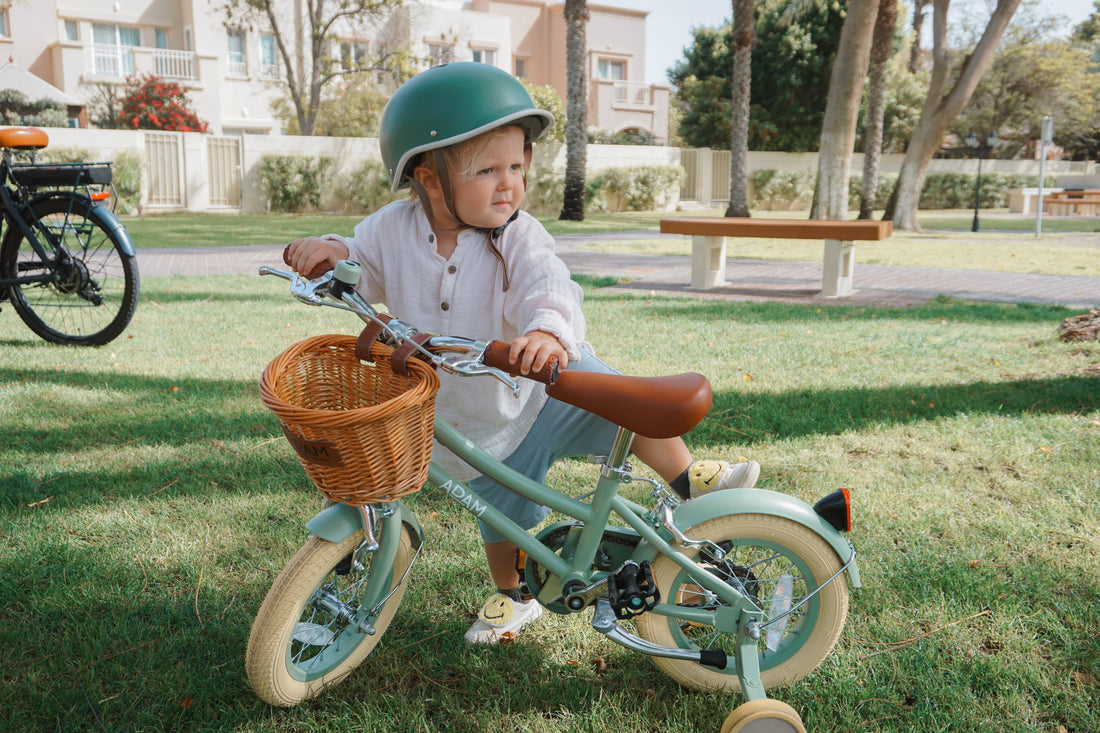
How to learn bicycle balance: Easy tips to ride confidently as a beginner
Share
Learning to balance on a bicycle opens up a whole new world for your family. Whether you're introducing your toddler to their first balance bike or helping an older child master two wheels, this guide will help you build confidence and create joyful cycling moments together - right here in Dubai.
For young riders, starting with a balance bike is the easiest and most effective path. By focusing on balance first, without the complication of pedals, kids develop natural stability and confidence. And the best part? Once they've mastered gliding, the transition to a pedal bike happens almost effortlessly.
Why Start with a Balance Bike?
Balance bikes transform how children learn to ride. Instead of relying on training wheels - which can actually delay true balance development - kids learn to steer, balance, and coordinate their movements naturally. They push off with their feet, glide, and gradually lift both feet as confidence grows.
This approach builds real cycling skills from day one. You'll notice your child developing spatial awareness, core strength, and that wonderful sense of independence that comes with mastering something new. For Dubai families looking to encourage active outdoor time, balance bikes turn park visits into mini-adventures.
Choosing the Right Balance Bike
The right fit makes all the difference. When your child sits on the saddle, both feet should rest flat on the ground with knees slightly bent. This gives them the confidence to catch themselves and the control to push off effectively.
Adam Store Tip: Our Baby Adam 10 balance bike is designed for Dubai's youngest riders - lightweight aluminum frame perfect for toddlers learning in parks, with puncture-resistant tires that handle both smooth pathways and occasional sandy patches you'll find around neighborhood play areas.
Look for bikes with:
- Adjustable seat height to grow with your child
- Lightweight frames they can actually control
- Comfortable grips for small hands
- Quality construction that handles regular use
Best Times and Places to Practice in Dubai
Timing matters in Dubai's climate. Early mornings (6:30-8:30 AM) and late afternoons (4:30-6:30 PM) offer comfortable temperatures for practice sessions. Dubai's beautiful winter months (November through March) are absolutely perfect for longer outdoor learning sessions.
Start on smooth, flat surfaces where your child can focus purely on balance:
- Community park pathways - Wide, smooth paths with minimal foot traffic early morning
- Your compound's quiet streets - Familiar, safe spaces without car concerns
- Shaded walking paths - Tree-lined areas that offer relief even during warmer months
- Indoor parking areas - A surprising option for hot summer days when outdoor practice isn't comfortable
Look for gentle, almost imperceptible slopes - these help kids experience gliding without needing much speed.
Step-by-Step: Teaching Your Child to Balance
Keep it playful and pressure-free. Your enthusiasm matters more than perfection. Here's how to guide your child through the process:
1. Start with Walking
Let them walk the bike between their legs, getting comfortable with the weight and feel. Make it a game - "Can you walk to that tree?" This builds familiarity and confidence.
2. Introduce Scooting
Encourage them to sit on the saddle and scoot along using both feet. They're learning to support the bike's weight while moving. Celebrate this stage - it's where the magic begins.
3. Practice Gliding
This is the breakthrough moment. As they scoot faster, encourage them to lift both feet simultaneously, even for just a second. Start with tiny glides and gradually extend the distance. You'll see their face light up when they realize they're balancing!
4. Add Steering
Once gliding feels natural, set up simple courses using cones or chalk marks. Gentle turns teach them how steering affects balance - a crucial skill they'll use forever.
5. Build Duration
With practice, those one-second glides become five seconds, then ten. Before you know it, they're coasting across the entire park path with feet up, grinning from ear to ear.

Safety Essentials
Always use a properly fitted helmet. This single step removes fear from both you and your child, allowing them to focus on learning rather than worrying about falls. Make helmet-wearing non-negotiable from day one - it establishes lifelong habits.
Adam Store Tip: Our kids' helmets are designed for Dubai's heat with extra ventilation - keeping your child cool and protected during those early morning practice sessions at the park.
Keep sessions short and sweet:
- 15-20 minutes for toddlers - Their attention span and physical stamina need frequent breaks
- 20-30 minutes for older preschoolers - Building endurance while maintaining enthusiasm
- End on a high note - Stop when they're still having fun, not when they're frustrated or exhausted
Common Challenges (and How to Handle Them)
"My child won't lift their feet" This is completely normal. Don't push it. Let them scoot as long as they need - some kids take days, others weeks. The confidence will come. Try finding a very gentle slope where gravity naturally helps them glide.
"They're scared of going fast" Respect their pace. Balance isn't about speed; it's about control. Some children are cautious learners, and that's perfectly okay. Celebrate every tiny bit of progress.
"We're not seeing progress" Keep sessions regular but brief. Three 15-minute sessions weekly work better than one long Sunday marathon. And remember - every child's timeline is different. Your encouragement matters more than rapid results.
Exercises That Build Balance Skills
Between bike sessions, these activities naturally strengthen the same skills:
- Walking on low walls or curbs - Develops balance awareness in a fun way
- Playing on playground equipment - Climbing and swinging build core strength
- Beach walks - Walking on sand challenges stability (and it's a Dubai family favorite!)
- Standing on one foot games - Simple indoor fun that translates to better bike control
The goal isn't structured training - it's weaving balance-building into everyday family activities.

Transitioning to a Pedal Bike
Once your child can glide confidently for 10-15 meters with feet up, they're ready to consider pedals. Most children transition seamlessly because they've already mastered the hardest part: balance.
Adam Store Tip: When your child's ready to level up, our Little Adam 12 Pedal Bike offers the perfect next step - same quality Dutch design, with pedals added. The familiar upright riding position makes the transition feel natural rather than overwhelming.
The transition typically takes just days, not weeks. Since they already know how to balance and steer, adding pedals is simply learning a new motion with their legs.
Creating Positive Learning Moments
This journey is about more than learning to ride. You're building your child's confidence, showing them that new skills take practice, and creating memories of sunny Dubai mornings spent together outdoors.
Stay patient. Offer genuine encouragement. Let them progress at their own pace. And most importantly - smile and show them you believe in their ability to succeed.
Every child reaches that magical moment when everything clicks. When they glide across the park, feet up, wind in their hair, realizing they're truly balancing. That moment - that pure joy - makes every wobbly practice session worthwhile.
Ready to start your family's balance bike journey? The confidence and independence your child gains will extend far beyond cycling - into playground adventures, school activities, and a lifetime of active outdoor enjoyment. Those early morning practice sessions? They become treasured family memories faster than you'd imagine.
